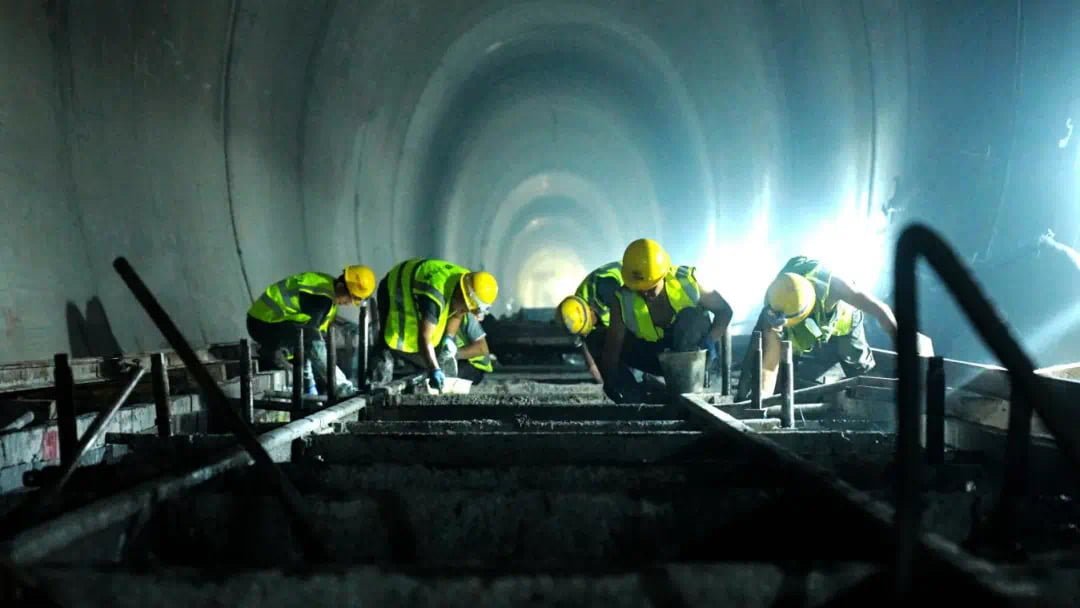
The construction of the Haba Snow Mountain Tunnel on the Lijiang to Shangri-La section of the Dali-Lhasa Railway was completed after 9 years of hard work by the construction team. This marks the completion of all 20 tunnels on this section of the railway, and the project will now move into the phase of laying long rails.
#image_title
The construction personnel from China Railway 16th Bureau worked tirelessly to pour concrete, completing the final section of the Haba Snow Mountain Tunnel with ballast less track bed construction. This achievement is a significant breakthrough in the construction of complex geological tunnels on the plateau and provides valuable experience for future similar tunnel projects.
The Haba Snow Mountain Tunnel, located in the Diqing Tibetan Autonomous Prefecture of Yunnan Province, is 9.5 kilometers long and has a maximum burial depth of 1155 meters. It is classified as a Class I high-risk tunnel and is a key and challenging project on the entire line. The tunnel is situated on the southeastern edge of the Qinghai-Tibet Plateau, in the middle section of the Hengduan Mountains, and is greatly influenced by highland stress, plate tectonic compression, and fault zone activity.
During the construction process, geological issues such as significant deformations of soft rocks were particularly prominent, making it the most difficult soft-rock deformation tunnel in China and even the world.
Lin Ke, the chief engineer of the Lixiang Railway Project Department of China Railway 16th Bureau, explained that the allowed contact pressure between the initial support and the secondary lining of a general tunnel is 0.5 mega pascal . However, during the construction of the Haba Snow Mountain Tunnel, the measured contact stress between the initial support and the secondary lining reached 2.37 megapascals, almost 5 times the maximum allowable contact stress in the design.
Due to highland stress and weak surrounding rock, the tunnel was prone to arch collapse and deformation of the initial support. To overcome these challenges, the participating units collaborated with universities and research institutes, conducted research and exploration, invited experts to conduct tunnel inspections, and conducted numerous studies and practical explorations. This led to the development of a set of large deformation control technical measures, obtaining multiple utility model patents and invention patents, as well as provincial construction methods. These achievements provide practical explorations and technical experience for the construction of plateau railways in China, filling the gap in tunnel construction in the country.
The Lijiang to Shangri-La section of the Dali-Lhasa Railway is located in the northwest of Yunnan Province, connecting Lijiang City and Diqing Tibetan Autonomous Prefecture. It is a crucial part of China's "Medium-to-Long-Term Railway Network Plan" for the Dali-Lhasa Railway. Starting from Lijiang Station and heading north through Tiger Leaping Gorge, Xiaozhongdian Town to Shangri-La, the section has a total length of 139.7 kilometers and a design speed of 140 kilometers per hour. It is equipped with four stations: Lijiang Station, Lashi Lake Station, Xiaozhongdian Station, and Shangri-La Station.
Once completed and opened, it will connect the Diqing Tibetan Autonomous Prefecture of Yunnan Province to the railway network, fill transportation gaps in the northwest of Yunnan Province, and contribute to the development of the tourism economy in the ethnic minority areas of northwest Yunnan.
https://bit.ly/3O5GcJL
Comments
Post a Comment